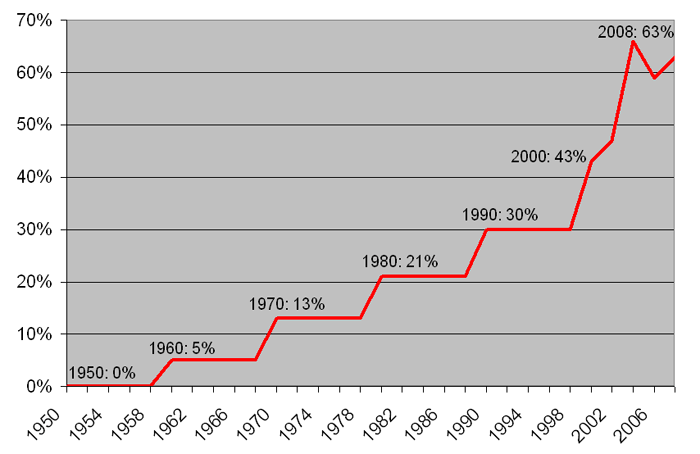For GOP's Sake, Texas Better Not Secede
A Commentary by Rhodes Cook
Of all the jaw-dropping comments made by politicians this year, the one that takes top prize was not uttered in the nation's capital but deep in the heart of Texas. There, in conjunction with a tax day "tea party," Republican Gov. Rick Perry floated the idea of his huge state along the Mexican border seceding from the Union.
As explanation, Perry declared that "we've got a great Union. There's absolutely no reason to dissolve it. But if Washington continues to thumb their nose at the American people, who knows what may come of that?"
Wacky and silly has been a common reaction to the idea of Texas' secession. Yet to those who take the idea at all seriously, responses range from potentially treasonous to "close the door behind you on the way out." As a political matter, it would be about the worst thing that could possibly happen to Perry's Republican Party at a time that it holds neither end of Pennsylvania Avenue and is a receding force in many states.
Without a doubt, Texas is the cornerstone of the modern Republican Party. In 2008, it gave the GOP more electoral votes and elected more Republican House members than any other state.
The 20 House Republicans from the Lone Star state is one more than the number that hails from the nation's largest state, California.
The 34 electoral votes that Texas provided John McCain were more than twice as many as he could garner from anywhere else--with Georgia a distant number two for Republicans with 15 electoral votes.
Without Texas, the state of the GOP would assume nightmarish proportions. With Texas, Republicans still have major problems but are a factor on the national stage.
Assuming it stays in the Union (seemingly a good bet), Texas could be even more of a prize for Republicans in the future than it is now. The state is projected to gain upwards of four House seats in the 2010 census, which would mean at least four more electoral votes for Texas in the next decade.
Republican hegemony will be difficult to break in the short run. Democrats have not carried Texas in a presidential election since 1976 (when Jimmy Carter won), not elected a senator since 1988 (Lloyd Bentsen), and not captured the governorship since 1990 (Ann Richards).
And in recent years, the GOP has not just been winning major races in Texas, but winning big. Since 2000, Republicans have swept every contest but one for president, senator and governor by a margin of at least 10 percentage points. The lone exception, Perry's gubernatorial reelection in 2006, was achieved by a clear-cut margin of 9 points.
A Republican congressional majority has been more difficult to come by. But thanks to a controversial, GOP-orchestrated re-map in the middle of this decade, Republicans now control most of Texas' U.S. House seats as well.
Chart 1. GOP On a Roll in Texas
Texas Democrats have not won a statewide election for president, senator or governor since Ann Richards' gubernatorial victory in 1990. Throughout this decade, Republicans have not only won but won big--sweeping every major statewide race except one by a margin of at least 10 percentage points. The exception came in 2006, when GOP Gov. Rick Perry won re-election in a four-way race by a margin of 9 percentage points. Presidential elections are indicated below in BOLD type, with the name of the Republican winner capitalized.
|
Percentage of
|
|||||
|
Election |
Office |
Texas Winner |
Rep. |
Dem. |
Plurality
|
|
2000 |
PRESIDENT |
GEORGE W. BUSH |
59% |
38% |
1,365,893 |
|
2000 |
Senator |
Kay Bailey Hutchison |
65% |
32% |
2,051,776 |
|
2002 |
Governor |
Rick Perry |
58% |
40% |
812,793 |
|
2002 |
Senator |
John Cornyn |
55% |
43% |
540,485 |
|
2004 |
PRESIDENT |
GEORGE W. BUSH |
61% |
38% |
1,694,213 |
|
2006 |
Governor |
Rick Perry |
39% |
30% |
406,455 |
|
2006 |
Senator |
Kay Bailey Hutchison |
62% |
36% |
1,106,587 |
|
2008 |
PRESIDENT |
JOHN McCAIN |
55% |
44% |
950,695 |
|
2008 |
Senator |
John Cornyn |
55% |
43% |
948,104 |
Note: The partisan percentages are based on the total vote cast for that office.
Source: America Votes 27 (CQ Press) for elections from 2000 through 2006; the web site of the Texas secretary of state for 2008 elections.
Democratic Hopes
In spite of this wall-to-wall Republicanism, Democrats nurture hopes of turning Texas "Blue" by coupling the state's burgeoning minority population with existing pockets of liberalism in cities such as Austin. The state is currently one of just four with a "majority minority" population. (California, Hawaii and New Mexico, as well as the District of Columbia, are the others.)
Yet if there is a realignment under way in Texas, it is a slow-motion one. Hispanics, in particular, do not vote anywhere near their proportion of the state population. While they comprise fully one-third of Texas' population, they cast just 20 percent of the ballots in the 2008 presidential election. Meanwhile, whites cast more than 60 percent of the statewide vote and favored McCain by a ratio of 3 to 1.
The conservative nature of much of the electorate in the Lone Star state was a major factor in Barack Obama's inability to run well among voting groups that were critical to his success elsewhere--independents, the young, and those with a post-graduate education. Election exit polls (posted on the CNN web site) showed that Obama carried barely one-third of the vote cast by Texas independents and postgrads, while marshaling a slim majority of the youth vote (age 18-29) that was well below his national rate.
That said, Obama was still able to score some notable breakthroughs in Texas that have left Democrats hopeful that the era of Republican dominance is passing.
He carried three of the four Texas counties with a population of at least 1 million--Bexar (San Antonio), Dallas and Harris (Houston)--bringing the latter two into the Democratic presidential column for the first time since Lyndon Johnson's landslide victory in 1964. Obama benefited from the growing Hispanic population in the urban centers. Bexar County, for instance, is now majority Hispanic, while both Dallas and Harris counties are close to 40 percent Hispanic.
In the almost unanimously Hispanic counties of south Texas, the story was the breadth of Obama's appeal. Democrats normally run well in this part of the state. But in the populous counties that line the Rio Grande River from Brownsville to El Paso, Obama's winning share of the vote tended to run 10 to 15 percentage points higher than the Democratic share in 2004, when the popularity of Texas' own George W. Bush reduced the Democratic Party's normal margins along the Mexican border.
And Obama ran much more competitively than recent Democratic candidates in the fast-growing suburban counties outside Houston, Austin and Dallas. He did not win any of them, but in several Obama was able to significantly whittle down the Democratic deficit. Case in point: Fort Bend County near Houston, the home base of former U.S. House Majority Leader Tom DeLay. A 15 point Republican advantage in the county in the 2004 presidential race was trimmed to 2 points last November.
Chart 2. For Texas Republicans, Congressional Majority a Long Time Coming
While Democrats began shedding major offices in Texas several decades ago, they were able to retain a majority of seats in the state's U.S. House delegation until 2004. Then, a GOP-orchestrated, mid-decade redistricting plan dramatically shifted control from the Democrats to the Republicans.
|
U.S. House Seats |
|||
|
Election |
Democrats |
Republicans |
% of Texas' House
|
|
1950 |
21 |
0 |
0% |
|
1960 |
21 |
1 |
5% |
|
1970 |
20 |
3 |
13% |
|
1980 |
19 |
5 |
21% |
|
1990 |
19 |
8 |
30% |
|
2000 |
17 |
13 |
43% |
|
2002 |
17 |
15 |
47% |
|
2004 |
11 |
21 |
66% |
|
2006 |
13 |
19 |
59% |
|
2008 |
12 |
20 |
63% |
Note: U.S. House totals are after each election indicated.
Source: Guide to U.S. Elections, Vol. II (CQ Press).
Republican Share of Texas' U.S. House Seats
Yet outside the major metropolitan areas and Hispanic south Texas, Obama hit a brick wall. Of the state's 254 counties, he carried only 28. Typical of his limited appeal in rural Texas was the vote in heavily white Blanco (Johnson City) and Fannin (Bonham) counties. They were home to two of Texas' most famous 20th century Democrats, LBJ and long-time House Speaker Sam Rayburn, respectively. Yet in 2008, Obama drew less than one-third of the vote in each county--showings that underscored his and his party's problems among white Texas voters in general.
Democrats will clearly have to do better in the small cities and towns of Texas if they are to turn the state into a battleground. But they should find out quickly if they are making any significant progress. Next year will be the first in more than 30 years where a member of the Texas-based Bush family was neither in office nor on the ballot (with the exception of a brief two-year span in the early 1990s).
And vying to lead the Republican ticket in 2010 will be Gov. Perry, who is arguably the weakest link in the state GOP hierarchy. Perry was reelected in 2006 with just 39 percent of the vote, in a four-way contest that featured a pair of colorful independent candidates, former Texas Comptroller Carole Keeton Strayhorn (the mother of Bush White House press secretary Scott McClellan) and Texas satirist Richard "Kinky" Friedman.
Next year, Perry will face a primary challenge from GOP Sen. Kay Bailey Hutchison, who has won four straight Senate elections since 1993 with at least 60 percent of the vote. If Perry can survive the primary, he will be the favorite in the fall. For Texas is still a reliably Republican state, until realignment--or secession--takes place.
See Other Commentary by Rhodes Cook
See Other Political Commentary
Views expressed in this column are those of the author, not those of Rasmussen Reports.
Rasmussen Reports is a media company specializing in the collection, publication and distribution of public opinion information.
We conduct public opinion polls on a variety of topics to inform our audience on events in the news and other topics of interest. To ensure editorial control and independence, we pay for the polls ourselves and generate revenue through the sale of subscriptions, sponsorships, and advertising. Nightly polling on politics, business and lifestyle topics provides the content to update the Rasmussen Reports web site many times each day. If it's in the news, it's in our polls. Additionally, the data drives a daily update newsletter and various media outlets across the country.
Some information, including the Rasmussen Reports daily Presidential Tracking Poll and commentaries are available for free to the general public. Subscriptions are available for $4.95 a month or 34.95 a year that provide subscribers with exclusive access to more than 20 stories per week on upcoming elections, consumer confidence, and issues that affect us all. For those who are really into the numbers, Platinum Members can review demographic crosstabs and a full history of our data.
To learn more about our methodology, click here.



